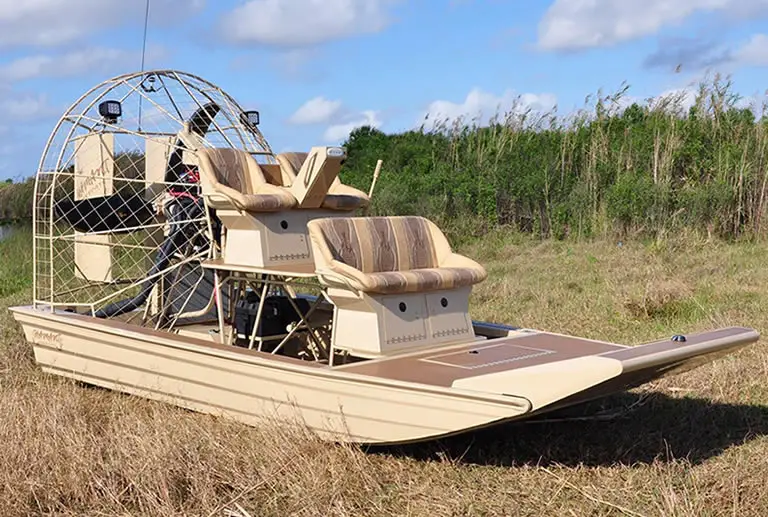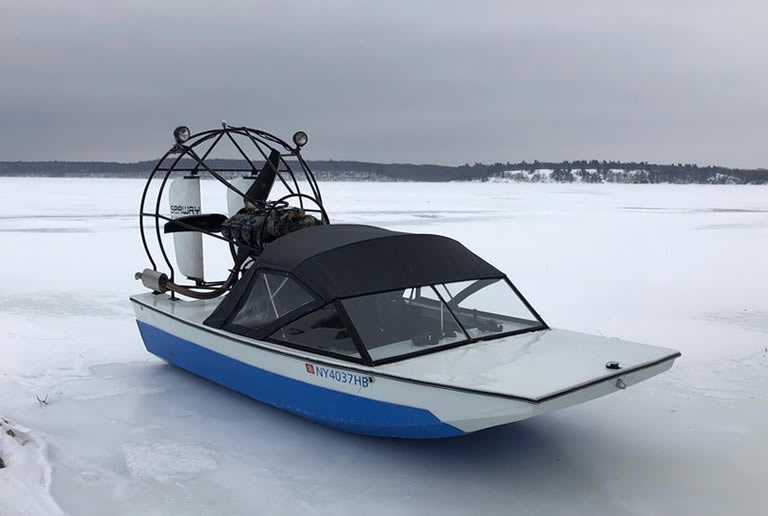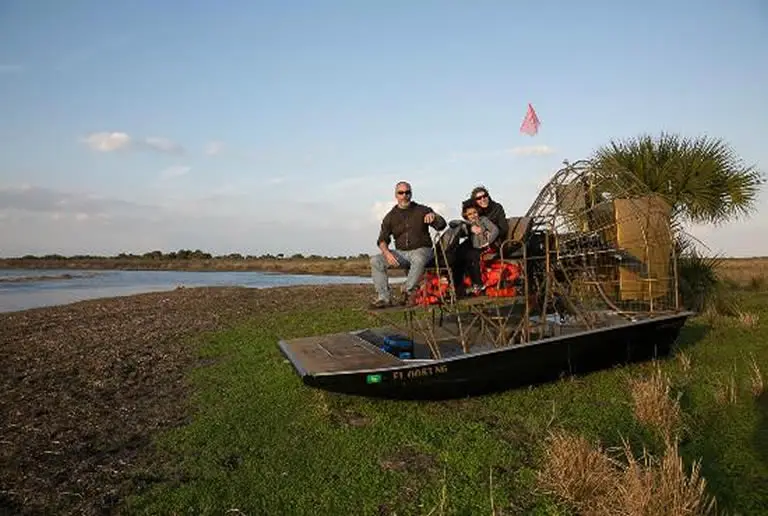Airboats are great watercraft for shallow waters and swamps. This is why they are used in places like the Florida Everglades and the swamps of Mississippi as touring boats. The flat bottom allows them easy access to shallow water. But with no moving parts under the water can an airboat go on land?
Contents
Can An Airboat Go On Land?
An airboat can go over land as long as it is not rocky or very uneven.
Airboats are regularly used to move across muddy areas when moving from one body of water to another.
There is more resistance that is encountered when moving across land and therefore more power is required.
Some smaller airboats do not have this power and will struggle on land.
Airboats that have been modified so the exhaust sits below the boat cannot go over land.
Why an airboat can move over land
Why can an airboat move over land?
Well, it’s all in the boat’s unique design.
An airboat has a flat bottom hull. This means the bottom of the boat is completely flat.

This flat bottom does not just give an airboat the shallow draft which allows it to be used in shallow water but it also allows the boat to be used over land.
Obviously having a flats bottom makes it is easier for the boat to move over flat surfaces, such as land.
But if a flat bottom hull means you can move over land why can’t other flat bottom boats do the same?
To answer that question let’s look a common type of flat bottom boat – the Jon boat.
A Jon boat is a typical flat bottom boat with a shallow draft that is used in similar shallow water environments as an airboat.
Its shallow draft means it can access waterways with water depth only 2″ deep.
However, this type of boat cannot access water skinnier than this, or likewise be used on land, simply because it would have no means of propulsion.
The hull of the boat may be capable of moving over flat land but with no form of propulsion to move the boat it wouldn’t be able to go anywhere.
Let me explain.
When a Jon boat moves from deeper water to shallower water the boater must trim the motor up completely to lift the prop out of the water.
He/she does this because leaving the prop in the water would result in it getting damaged on the bottom.
The boater must then rely on a form of manual propulsion, such as a paddle, pole or even oars to move the boat.
Obviously these methods of propulsion do not work in water with depth less than 2″.
This is because there is no way to push the boat forward; there is simply not enough water to push with a paddle or oar.
Likewise, using a pole to push the boat would require too much physical effort as the boat experiences resistance from the river bottom.
And, the motor cannot be engaged either because there is not enough clearance for the propeller.
So as you can see although the hull design of a flat bottom boat would allow it to be used on land, the overall workings of the boat will not.
An airboat has no such restrictions.
Because an airboat has all its moving parts on the boat, including the engine and propeller, it has nothing below the boat that could snag on the bottom.
Also, because the propeller is situated on the boat, rather than under the boat, it has a form of propulsion that can work without the need for any type of water depth.
Thus the motor and propeller on an airboat will push the boat forward regardless of what type of terrain the boat is on while its flat bottom hull allows it to slide over land.
What type of land can an airboat move on?
An airboat is best used on flat land that is grassy or muddy.
This way the bottom of the boat is protected to some degree from damage caused by friction.
Grassy areas are common in swamps where airboats are used regularly and it makes sense to simply boat over the land from one body of water to another.
So too muddy areas offer the perfect type of slippery surface for an airboat to effortlessly glide across.
Of course as there is more friction is encountered, by the bottom of the boat running over land than water, more power is needed to push the boat forward.
Although grassy and muddy areas are the best types of land to move on in an airboat, technically speaking an airboat can move over any relatively flat land mass.
However, its pretty obvious that gunning an airboat down a flat paved road will case more than a few scratches to the bottom of the hull, even if it is technically possible!
Airboat moving over land (video)
What land is unsuitable for an airboat?
Obviously not all land types are suitable for airboat use (paved roads aside).
Trying to cross rocky terrain in an airboat will simply result in damage to your boat, while very uneven land masses will likely cause the same problems.
What type of airboats can’t go on land?
There are certain airboats that cannot go on land.
Low-powered and small prop airboats as well as modified boats with the exhaust system located below the boat cannot be used over land.
Some personal airboats are small, have medium-sized engines and small propellers.
Although these watercraft are fine moving across shallows, and even deep water, they will struggle if taken over land for any length of time.
In fact, some may not even make it past the bank.
These boats are few and far between though, as an airboat usually has enough power to push it over almost any flat surface.
In Florida there is a law that was introduced back on 1st October 2006 that states airboats must be fitted with an adequate noise-reducing system.
Although most airboat owners and tour operators will fit mufflers, along with noise-reducing carbon composite propellers, to their boats to comply with this law, some private owners don’t.
They simply relocate the exhaust system below the boat to allow the water to naturally muffle the sound.
Obviously moving anything that is located on the boat to under the boat immediately effects the design of the boat.
This has little effect on the actual draft of the boat, meaning it can still be used to access shallow water. Though it does completely eliminate the ability to move the boat over land.
An airboat can also move over ice
Airboats can also move easily over land, or water, that is covered in ice.
The flat bottom hull makes gliding over ice easy.

In fact, using an airboat on ice is also a lot of fun.
As there are no moving parts below the boat there is nothing to impede the flat bottom from sliding over the ice.
Summary: How An Airboat Can Easily Move Over Land
Most airboats can be used over land as long as the land is relatively flat and has no obvious obstacles.
Airboats can do this because they have a flat bottom and no moving parts underneath the boat.
Grassy and muddy land areas are the best land types for airboats while rocky and very uneven land areas are unsuitable.
Small airboats with small engines and small propellers may struggle on land.
Modified airboats with their exhaust system relocated to a place underneath the boat cannot be used on land as the exhaust system would get damaged.
Airboats can also be used on ice-covered land and iced-over bodies of water as the flat bottom hull will effortlessly glide across the ice.

